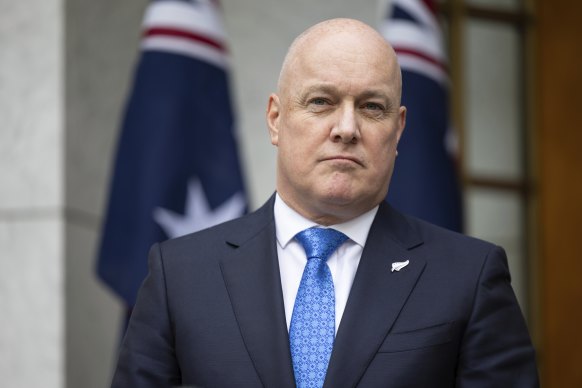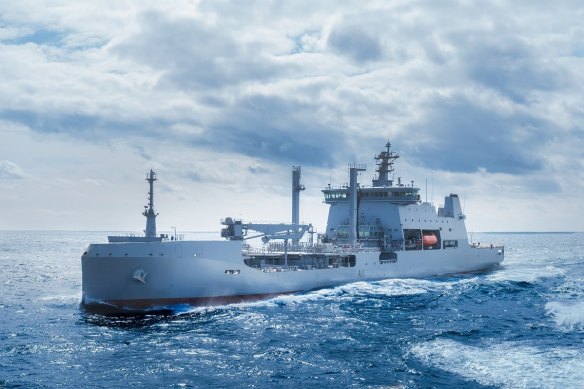- Analysis
- World
- Oceania
- China relations
This was published 7 months ago
New Zealand’s biggest pivot since the 1980s
By The Economist
Wellington: On September 25, the Aotearoa, one of just a handful of ships in the Royal New Zealand Navy, sailed through the Taiwan Strait alongside an Australian destroyer. The idea was to demonstrate to China that its claims to sole control of the waterway are invalid under international law. The United States does it several times a year, despite condemnations from China, sometimes with allies such as Canada. Australia does, too. New Zealand has not made such a bold move since 2017.
In an interview with The Economist, Christopher Luxon, New Zealand’s prime minister, notes that, as a small trading nation, New Zealand depends on freedom of navigation. All countries, he says, including China, need to adhere to international law. He plays down the voyage itself: he argues it was just the quickest way for the ship to sail from the East China Sea to the South China Sea.

New Zealand Prime Minister Christopher Luxon.Credit: Alex Ellinghausen
But the Aotearoa’s transit underscores a big shift in New Zealand’s foreign policy under Luxon, who took office as the head of a coalition government in November last year. His “reset”, as he calls it, has two elements. The first is a push to diversify New Zealand’s diplomatic and trade relationships away from its reliance on China, which takes 27 per cent of its exports. This is mostly uncontroversial.
The second is to bring New Zealand into closer alignment with the other four countries in the Five Eyes, an agreement between the US, Australia, Britain, Canada and New Zealand to share intelligence. As part of that, Luxon is prepared to align New Zealand more closely with the US than at any point since the two former allies went their separate ways in 1986. The latter change has provoked one of the most spirited debates in New Zealand on foreign policy since that time.
New Zealand is the only Five Eyes country that is not a US ally. That is unlikely to change, at least on paper. The US suspended its defence commitments to New Zealand under the ANZUS alliance in 1986 in response to a ban by New Zealand on nuclear weapons in its ports. Because the US navy doesn’t disclose which of its ships are carrying nukes, that made an alliance impossible.
In the years that followed, New Zealand’s governments of the left and right staked out a new foreign policy for the country. They forged deeper diplomatic ties with New Zealand’s closest neighbours, the small island countries of the Pacific, and traded more with a rising Asia. But it was only “semi-aligned” with the West, according to Helen Clark, who served as prime minister from 1999 to 2008. It avoided getting involved with the war in Iraq, but sent special forces to help NATO fight the Taliban in Afghanistan.
It also got rich. In 2008, Clark’s government signed a free-trade agreement with China. The pact, which removed 98 per cent of Chinese tariffs on New Zealand’s exports, spared it the worst effects of the global financial crisis. But most of New Zealand’s exports to China are highly substitutable agricultural goods, making it vulnerable to economic coercion.
And as trade with China grew, so did other links between the two, not all of them benign. Under Labour governments from 2017 to 2023, prompted by intelligence-agency warnings, New Zealand cracked down on Chinese attempts to interfere in its politics. It tightened an investment screening process and banned foreign campaign donations.
Although maligned by some critics as the weak link in the Five Eyes, intelligence experts from the other members say that New Zealand’s security services are solid. The agencies are small, but do good work in the Pacific islands and in intercepting adversaries’ internet and satellite communications. There have been no embarrassing counter-intelligence lapses.
It is on defence that New Zealand’s long estrangement from the US has prevented it from making more of a contribution to upholding the rules-based order in Asia. Luxon seems ready to change that. The sailing through the Taiwan Strait, which was followed by multilateral exercises in the South China Sea, is one example. New Zealand has also stepped up its contribution to the multinational taskforce working to prevent North Korean oil-smuggling. The taskforce’s work has angered China, even though it is operating under the authority of a UN Security Council resolution, because China fears that it is also snooping on them.

Helen Clark, former New Zealand prime minister, whose government signed a free-trade agreement with China in 2008.Credit: Bloomberg
And Luxon has continued some of the Labour government’s earlier, tentative moves in this direction, including a look at joining AUKUS, the defence pact signed in 2021 between Australia, the US and Britain. New Zealand wouldn’t take part in efforts to develop nuclear-powered submarines for Australia, but it might join the pact’s second “pillar”, focused on advanced defence technologies.

The Royal New Zealand Navy’s Aotearoa vessel.
Critics, like Clark, say that none of this is in New Zealand’s interests. Semi-alignment has served New Zealand well. “It takes longer to fly from Auckland to Beijing than from Beijing to London. We are a long way south and very remote,” she says. But Chinese attempts to sign Pacific island countries up to security agreements over the past three years, and suspicions regarding China’s expanded presence on Antarctica mean that even New Zealand cannot stay out of the way of geopolitics.
If Luxon wants to be more than a bystander, however, he will face real constraints. New Zealand’s defence force is smaller than that of any of the US’ allies or partners in Asia. Its army can muster no more than a brigade. Its air force gave up fighter jets decades ago. And its navy is down to eight ships, following an accident which saw a survey vessel sink off the coast of Samoa on October 6.
The government plans to release a defence-capabilities plan later this month. Luxon will not be drawn on the report’s recommendations before its release. But its choices will reveal much about how far it is willing to go, according to David Capie at Victoria University of Wellington. If naval plans focus on small patrol boats, for example, it would suggest a force concerned with its neighbourhood and tied to New Zealand’s “semi-aligned” foreign policy. If it opts to invest in higher-end capabilities like frigates, however, that would signal a New Zealand ready to do more with Australia and the US to uphold the rules-based order.
One seemingly inexhaustible resource is Luxon. Ten months into office, the new prime minister has already visited the US, Japan, South Korea and half of the countries of Southeast Asia. Each is at least a 12-hour flight from Wellington, the capital. When your correspondent interviewed Luxon, he was in Laos. Asked about his travel schedule, Luxon shrugs. Before politics, he spent seven years as CEO of Air New Zealand.
© 2024 The Economist Newspaper Limited. All rights reserved.
Get a note directly from our foreign correspondents on what’s making headlines around the world. Sign up for our weekly What in the World newsletter.